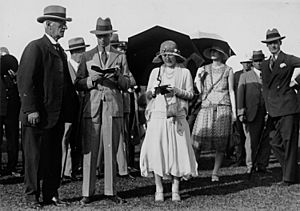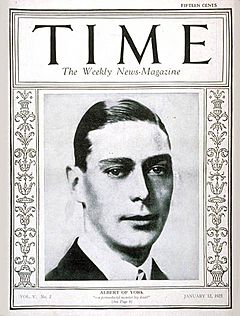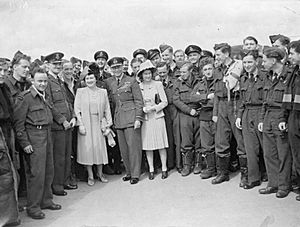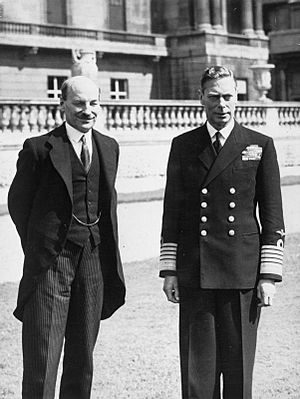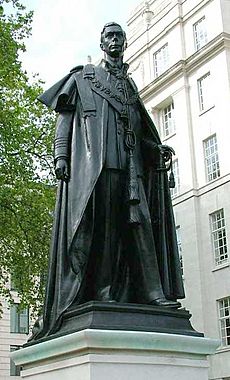George VI facts for kids
Quick facts for kids George VI |
|||||
|---|---|---|---|---|---|
| Head of the Commonwealth | |||||
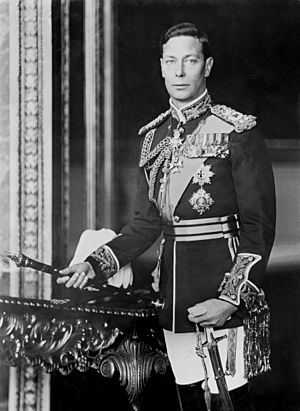
Portrait by Walter Stoneman, 1938
|
|||||
| King of the United Kingdom and the British Dominions | |||||
| Reign | 11 December 1936 – 6 February 1952 | ||||
| Coronation | 12 May 1937 | ||||
| Predecessor | Edward VIII | ||||
| Successor | Elizabeth II | ||||
| Emperor of India | |||||
| Reign | 11 December 1936 – 15 August 1947 | ||||
| Predecessor | Edward VIII | ||||
| Successor | Position abolished | ||||
| Born | Prince Albert of York 14 December 1895 York Cottage, Sandringham, Norfolk, England |
||||
| Died | 6 February 1952 (aged 56) Sandringham House, Norfolk, England |
||||
| Burial | 15 February 1952 Royal Vault, St George's Chapel, Windsor Castle
26 March 1969King George VI Memorial Chapel, St George's Chapel
|
||||
| Spouse | |||||
| Issue Detail |
|||||
|
|||||
| House |
|
||||
| Father | George V | ||||
| Mother | Mary of Teck | ||||
| Religion | Protestant | ||||
| Signature |  |
||||
| Education |
|
||||
| Military career | |||||
| Service/ |
|||||
| Years of active service | 1913–1919 | ||||
| Battles/wars |
|
||||
George VI (Albert Frederick Arthur George; 14 December 1895 – 6 February 1952) was King of the United Kingdom and the Dominions of the British Commonwealth from 11 December 1936 until his death on 6 February 1952. He was also the last Emperor of India from 1936 until the British Raj was dissolved in August 1947, and the first head of the Commonwealth following the London Declaration of 1949.
Contents
Early life
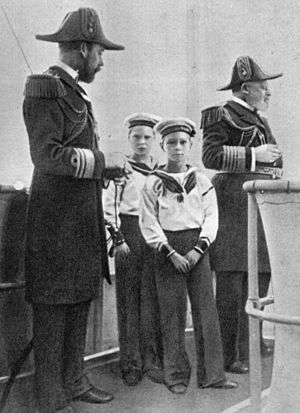
Albert was born at York Cottage, on the Sandringham Estate in Norfolk, during the reign of his great-grandmother Queen Victoria. His father was Prince George, Duke of York (later King George V), the second and only surviving son of the Prince and Princess of Wales (later King Edward VII and Queen Alexandra). His mother, the Duchess of York (later Queen Mary), was the eldest child and only daughter of Francis, Duke of Teck, and Princess Mary Adelaide, Duchess of Teck. His birthday, 14 December 1895, was the 34th anniversary of the death of his great-grandfather Albert, Prince Consort.
This circumstance upset the Queen at first, but she was gratified when the parents proposed to name the boy after the Queen's late husband. Consequently, he was baptised "Albert Frederick Arthur George" at St Mary Magdalene Church, Sandringham on 17 February 1896. Formally he was His Highness Prince Albert of York.
Albert was fourth in line to the throne at birth, after his grandfather, father and elder brother, Edward.
Queen Victoria died on 22 January 1901, and the Prince of Wales succeeded her as King Edward VII. Prince Albert moved up to third in line to the throne, after his father and elder brother.
Military career and education
Beginning in 1909, Albert attended the Royal Naval College, Osborne, as a naval cadet. In 1911 he came bottom of the class in the final examination, but despite this he progressed to the Royal Naval College, Dartmouth. When his grandfather Edward VII died in 1910, his father became King George V. Prince Edward became Prince of Wales, with Albert second in line to the throne.
Albert spent the first six months of 1913 on the training ship HMS Cumberland in the West Indies and on the east coast of Canada. He was rated as a midshipman aboard HMS Collingwood on 15 September 1913. He spent three months in the Mediterranean, but never overcame his seasickness. Three weeks after the outbreak of World War I he was medically evacuated from the ship to Aberdeen, where his appendix was removed by Sir John Marnoch. He was mentioned in dispatches for his actions as a turret officer aboard Collingwood in the Battle of Jutland (31 May – 1 June 1916), the great naval battle of the war. He had an operation for a duodenal ulcer in November 1917 and did not see further combat.
In February 1918 Albert was appointed Officer in Charge of Boys at the Royal Naval Air Service's training establishment at Cranwell. With the establishment of the Royal Air Force Albert transferred from the Royal Navy to the Royal Air Force. He served as Officer Commanding Number 4 Squadron of the Boys' Wing at Cranwell until August 1918, before reporting for duty on the staff of the RAF's Cadet Brigade at St Leonards-on-Sea and then at Shorncliffe. He completed a fortnight's training and took command of a squadron on the Cadet Wing.
Albert wanted to serve on the Continent while the war was still in progress and welcomed a posting to General Trenchard's staff in France. On 23 October, he flew across the Channel to Autigny. For the closing weeks of the war, he served on the staff of the RAF's Independent Air Force at its headquarters in Nancy, France. Following the disbanding of the Independent Air Force in November 1918, he remained on the Continent for two months as an RAF staff officer until posted back to Britain. He accompanied King Albert I of Belgium on his triumphal re-entry into Brussels on 22 November. Prince Albert qualified as an RAF pilot on 31 July 1919 and was promoted to squadron leader the following day.
In October 1919, Albert went up to Trinity College, Cambridge, where he studied history, economics and civics for a year, with the historian R. V. Laurence as his "official mentor". On 4 June 1920 his father created him Duke of York, Earl of Inverness and Baron Killarney.
Marriage
In 1920, he met for the first time since childhood Lady Elizabeth Bowes-Lyon, the youngest daughter of the Earl and Countess of Strathmore. He became determined to marry her. Elizabeth rejected his proposal twice, in 1921 and 1922, reportedly because she was reluctant to make the sacrifices necessary to become a member of the royal family. After a protracted courtship, Elizabeth agreed to marry him.
Albert and Elizabeth were married on 26 April 1923 in Westminster Abbey. As the bride was not of royal birth, it was considered a modernising gesture.
From December 1924 to April 1925, the Duke and Duchess toured Kenya, Uganda, and the Sudan, travelling via the Suez Canal and Aden. During the trip, they both went big-game hunting.
The Duke and Duchess had two children: Elizabeth (called "Lilibet" by the family, and the future Elizabeth II) who was born in 1926, and Margaret who was born in 1930. The close family lived at White Lodge, Richmond Park, and then at 145 Piccadilly, rather than one of the royal palaces. In 1931, the Canadian prime minister, R. B. Bennett, considered Albert for Governor General of Canada—a proposal that King George V rejected on the advice of the Secretary of State for Dominion Affairs, J. H. Thomas.
Personality
As a child, Albert was ill often and was described as "easily frightened and somewhat prone to tears". His parents did not take part in his day-to-day upbringing, as was the norm in aristocratic families of that era. He had a stutter that lasted for many years. Although naturally left-handed, he was forced to write with his right hand, as was common practice at the time. He had chronic stomach problems as well as knock knees, for which he was forced to wear painful corrective splints.
His stutter, and his embarrassment over it, together with a tendency to shyness, caused him to appear less confident in public than his older brother, Edward. However, he was physically active and enjoyed playing tennis. He played at Wimbledon in the Men's Doubles with Louis Greig in 1926, losing in the first round. He developed an interest in working conditions, and was president of the Industrial Welfare Society. His series of annual summer camps for boys between 1921 and 1939 brought together boys from different social backgrounds.
Because of his stutter, Albert dreaded public speaking. After his closing speech at the British Empire Exhibition at Wembley on 31 October 1925, one which was an ordeal for both him and his listeners, he began to see Lionel Logue, an Australian-born speech therapist. The Duke and Logue practised breathing exercises, and the Duchess rehearsed with him patiently. Subsequently, he was able to speak with less hesitation. With his delivery improved, Albert opened the new Parliament House in Canberra, Australia, during a tour of the empire with the Duchess in 1927. Their journey by sea to Australia, New Zealand and Fiji took them via Jamaica, where Albert played doubles tennis partnered with a black man, Bertrand Clark, which was unusual at the time and taken locally as a display of equality between races.
Reign
On 20 January 1936, George V died and Edward ascended the throne as King Edward VIII. However, Edward VIII Edward abdicated later that year to marry the twice-divorced American socialite Wallis Simpson. As heir presumptive to Edward VIII, Albert became king, taking the regnal name George VI.
Albert was reluctant to accept the throne. The day before the abdication, he went to London to see his mother, Queen Mary. He wrote in his diary, "When I told her what had happened, I broke down and sobbed like a child."
Across Britain, gossip spread that Albert was physically and psychologically incapable of being king. It was rumoured that the government considered bypassing him, his children and his brother Prince Henry, in favour of their younger brother Prince George, Duke of Kent. This seems to have been suggested on the grounds that Prince George was at that time the only brother with a son. However, there is no evidence to support these rumours.
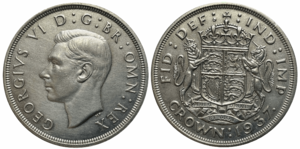
Albert assumed the regnal name "George VI" to emphasise continuity with his father and restore confidence in the monarchy. Three days after his accession, on his 41st birthday, he invested his wife, the new queen consort, with the Order of the Garter.
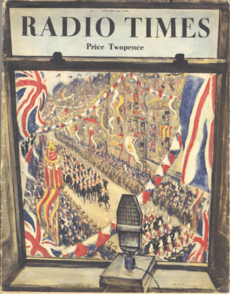
George VI's coronation at Westminster Abbey took place on 12 May 1937, the date previously intended for Edward's coronation. In a break with tradition, his mother Queen Mary attended the ceremony in a show of support for her son.
In May and June 1939, the King and Queen toured Canada and the United States; it was the first visit of a reigning British monarch to North America. Although the aim of the tour was mainly political, to shore up Atlantic support for the United Kingdom in any future war, the King and Queen were enthusiastically received by the public. They visited the 1939 New York World's Fair and stayed with President Franklin D. Roosevelt at the White House and at his private estate at Hyde Park, New York, and became friends with the head of the United States.
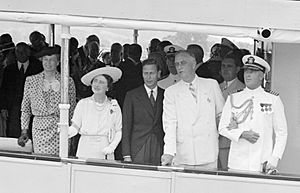
Second World War
In September 1939, the British Empire and most Commonwealth countries—but not Ireland—declared war on Nazi Germany. War with the Kingdom of Italy and the Empire of Japan followed in 1940 and 1941, respectively.
George VI was seen as sharing the hardships of the common people and his popularity soared. Buckingham Palace was bombed during the Blitz while the King and Queen were there, and his younger brother the Duke of Kent was killed on active service.
Throughout the war, George and Elizabeth provided morale-boosting visits throughout the United Kingdom, visiting bomb sites, munitions factories, and troops. George visited military forces abroad in France in December 1939, North Africa and Malta in June 1943, Normandy in June 1944, southern Italy in July 1944, and the Low Countries in October 1944. Their high public profile and apparently indefatigable determination secured their place as symbols of national resistance.

Britain and its allies were victorious in 1945, but the British Empire declined. Ireland had largely broken away, followed by the independence of India and Pakistan in 1947. George relinquished the title of Emperor of India in June 1948 and instead adopted the new title of Head of the Commonwealth.
In 1945, crowds shouted "We want the King!" in front of Buckingham Palace during the Victory in Europe Day celebrations. In an echo of Chamberlain's appearance, the King invited Churchill to appear with the royal family on the balcony to public acclaim.
Empire to Commonwealth
George VI's reign saw the acceleration of the dissolution of the British Empire. The process of transformation from an empire to a voluntary association of independent states, known as the Commonwealth, gathered pace after the Second World War.
George relinquished the title of Emperor of India, and became King of India and King of Pakistan instead. In late April 1949, the Commonwealth leaders issued the London Declaration, which laid the foundation of the modern Commonwealth and recognised George as Head of the Commonwealth. In January 1950, he ceased to be King of India when it became a republic. He remained King of Pakistan until his death. Other countries left the Commonwealth, such as Burma in January 1948, Palestine (divided between Israel and the Arab states) in May 1948 and the Republic of Ireland in 1949.
Illness and death
The stress of the war had taken its toll on George's health, made worse by his heavy smoking. He developed lung cancer, suffered from arteriosclerosis and Buerger's disease. A planned tour of Australia and New Zealand was postponed after George developed an arterial blockage in his right leg, which threatened the loss of the leg and was treated in March 1949. His elder daughter and heir presumptive, Elizabeth, took on more royal duties as her father's health deteriorated. The delayed tour was re-organised, with Princess Elizabeth and her husband, Philip, Duke of Edinburgh, taking the place of the King and Queen.
On 23 September 1951, he underwent a surgical operation where his entire left lung was removed by Clement Price Thomas after a malignant tumour was found. In October 1951, Elizabeth and Philip went on a month-long tour of Canada; the trip had been delayed for a week due to George's illness. At the State Opening of Parliament in November, the Lord Chancellor, Lord Simonds, read the King's speech from the throne. The King's Christmas broadcast of 1951 was recorded in sections, and then edited together.
On 31 January 1952, despite advice from those close to him, George went to London Airport to see Elizabeth and Philip off on their tour to Australia via Kenya. It was his last public appearance. Six days later, at 07:30 GMT on the morning of 6 February, he was found dead in bed at Sandringham House in Norfolk. He had died in the night from a coronary thrombosis at the age of 56. His daughter flew back to Britain from Kenya as Queen Elizabeth II.
From 9 February George's coffin rested in St Mary Magdalene Church, Sandringham, before lying in state at Westminster Hall from 11 February. His funeral took place at St George's Chapel, Windsor Castle, on the 15th. He was interred initially in the Royal Vault until he was transferred to the King George VI Memorial Chapel inside St George's on 26 March 1969. In 2002, fifty years after his death, the remains of his widow, Queen Elizabeth The Queen Mother, and the ashes of his younger daughter, Princess Margaret, who both died that year, were interred in the chapel alongside him. In 2022, the remains of Queen Elizabeth II and her husband, Prince Philip, were also interred in the chapel.
Legacy
George VI became king at a point when public faith in the monarchy was at a low ebb. During his reign, his people endured the hardships of war, and imperial power was eroded. However, as a dutiful family man and by showing personal courage, he succeeded in restoring the popularity of the monarchy.
The George Cross and the George Medal were founded at the King's suggestion during the Second World War to recognise acts of exceptional civilian bravery. He bestowed the George Cross on the entire "island fortress of Malta" in 1943. He was posthumously awarded the Order of Liberation by the French government in 1960, one of only two people (the other being Churchill in 1958) to be awarded the medal after 1946.
Colin Firth won an Academy Award for Best Actor for his performance as George VI in the 2010 film The King's Speech.
Interesting facts about George VI
- George VI was named Albert at birth after his great-grandfather Prince Albert of Saxe-Coburg and Gotha and was known as "Bertie" to his family and close friends.
- Prince Albert, as he was known at the time, took part in World War I. He is the only British Sovereign to have seen action in battle since William IV.
- He was the first member of the British royal family to be certified as a fully qualified pilot.
- As Albert began to take on more royal duties, he represented his father and toured coal mines, factories, and railyards. Through such visits he acquired the nickname of the "Industrial Prince".
- In January 1946, George addressed the United Nations at its first assembly, which was held in London, and reaffirmed "our faith in the equal rights of men and women and of nations great and small".
- His most famous quote is, "The highest of distinctions is service to others."
Titles, honours and arms
As Duke of York, Albert bore the royal arms of the United Kingdom differenced with a label of three points argent, the centre point bearing an anchor azure—a difference earlier awarded to his father, George V, when he was Duke of York, and then later awarded to his grandson Prince Andrew, Duke of York. As king, he bore the royal arms undifferenced.
Issue
| Name | Birth | Death | Marriage | Children | |
|---|---|---|---|---|---|
| Date | Spouse | ||||
| Elizabeth II | 21 April 1926 | 8 September 2022 | 20 November 1947 | Prince Philip, Duke of Edinburgh | Charles III Anne, Princess Royal Prince Andrew, Duke of York Prince Edward, Duke of Edinburgh |
| Princess Margaret, Countess of Snowdon | 21 August 1930 | 9 February 2002 | 6 May 1960 Divorced 11 July 1978 |
Antony Armstrong-Jones, 1st Earl of Snowdon | David Armstrong-Jones, 2nd Earl of Snowdon Lady Sarah Chatto |
Ancestry
| Ancestors of George VI | |||||||||||||||||||||||||||||||||||||||||||||||||||||||||||||||||||||||||||||||||||||||||||||||||||||||||||||||||||||||||||||||||||||||||||||||||||||||||||||||||||||||||||||||||||||||||||||||||||||||||||||||||||||||||||||||||||||||||||||||||||||||||||||||||||||||||||||||||||||||||
|---|---|---|---|---|---|---|---|---|---|---|---|---|---|---|---|---|---|---|---|---|---|---|---|---|---|---|---|---|---|---|---|---|---|---|---|---|---|---|---|---|---|---|---|---|---|---|---|---|---|---|---|---|---|---|---|---|---|---|---|---|---|---|---|---|---|---|---|---|---|---|---|---|---|---|---|---|---|---|---|---|---|---|---|---|---|---|---|---|---|---|---|---|---|---|---|---|---|---|---|---|---|---|---|---|---|---|---|---|---|---|---|---|---|---|---|---|---|---|---|---|---|---|---|---|---|---|---|---|---|---|---|---|---|---|---|---|---|---|---|---|---|---|---|---|---|---|---|---|---|---|---|---|---|---|---|---|---|---|---|---|---|---|---|---|---|---|---|---|---|---|---|---|---|---|---|---|---|---|---|---|---|---|---|---|---|---|---|---|---|---|---|---|---|---|---|---|---|---|---|---|---|---|---|---|---|---|---|---|---|---|---|---|---|---|---|---|---|---|---|---|---|---|---|---|---|---|---|---|---|---|---|---|---|---|---|---|---|---|---|---|---|---|---|---|---|---|---|---|---|---|---|---|---|---|---|---|---|---|---|---|---|---|---|---|---|---|---|---|---|---|---|---|---|---|---|---|---|---|---|---|---|
|
|||||||||||||||||||||||||||||||||||||||||||||||||||||||||||||||||||||||||||||||||||||||||||||||||||||||||||||||||||||||||||||||||||||||||||||||||||||||||||||||||||||||||||||||||||||||||||||||||||||||||||||||||||||||||||||||||||||||||||||||||||||||||||||||||||||||||||||||||||||||||
See also
 In Spanish: Jorge VI del Reino Unido para niños
In Spanish: Jorge VI del Reino Unido para niños



